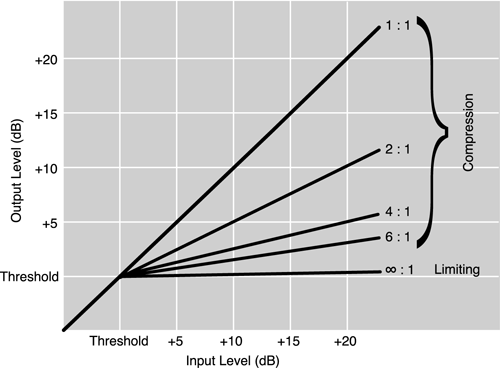We’ve seen that a compressor is acting based on a threshold (of Amplitude) to know when it should start compressing. We’ve also seen that with a gain control we can rise the output level of the whole signal after compression.
Let’s have a look at 3 other parameters that are going to change the way compression works: attack time, release time, and ratio.
Attack time
The first one, attack time allows to dial how fast a compressor is going to react to signal that is over the threshold. It can be very long (up to 500 milliseconds for some) or extremely short (down to 1 nanosecond). Changing the attack time will mostly change the way the attack of a sound will be treated. This is where we can say to a compressor: as soon as you hear a transient over the threshold you need to reduce it, or we can say, take your time to let the transient play over the threshold before you reduce the sound. So, in effect we can reduce the transients or emphasizes them relative to the sustain of the sound using that parameter.
For example, let’s look at a typical snare sound again, this whole sound will take 480 ms to ring, now if we setup an attack time to 220 ms we allow the attack/transient of the snare to pass through, but we reduce it’s sustain, so we make the snare sound ‘thinner’ which is the opposite of our example of last week, where we’ve reduced the attack/transient (with a fast attack), then added some gain to the whole signal to make it sound “fatter”.

Release time
The next parameter of a compressor is the release time, and it will tell the compressor how much time it will take before getting back to normal (letting the signal untouched). Dialing the release time is often used in EDM (Electronic Dance Music) to make the whole sound ‘pump’ (go up and down) in rhythm with the tempo, because it can be used to reduce the sound for a certain time between each new beat.
In general, if you want a compressor to act more naturally, you will want to dial a shorter release time, but it’s often dialed according to the tempo for the reason above. The longer the release time, the more compressed the overall sound will be, but if the release time is too short comparatively to the sustain and the beat, it will give the effect of sound levels pumping up and down, also too short release (not leaving time to the compressor to stop compressing) can create audio artifacts and too much pressure.
Ratio
The next parameter that is important to define how a compressor is going to process sound is the ratio.
The ratio is expressed as 2 numbers like 2:1 or 5:1 or more. The second number is always one, but the first number defines of how much decibels the compressor will reduce the sound for each decibel over the threshold. It is a divider.
A radio of 1:1 there’s no compression. For 1 dB of input there will be 1 dB of output. With a ratio of 2:1 when a sound is 2 dB over the threshold, it will be reduced to 1 dB, if it is 8 dB over the threshold, it will be reduced to 4 dB , if a sound is 1 dB above the threshold, it will be reduced to 0.5 dB . With a ratio of 5:1, a signal at 10 dB over the threshold will be reduced to 2 dB.

When the ratio is over 20:1 up to infinity:1 we’re talking about limiting. At infinity:1 this is also called brick-wall limiting, because no signal over the threshold will be able to pass (depending on the attack time some transients might be able to pass through briefly, but they will be reduced to the threshold level as soon as the attack – wait – time is over).
The ratio is an essential parameter, it defines how hard a compressor will compress the sound.
(Some advanced compressors also have a knee parameter, that defines how much of the compression is to happen around the threshold, allowing the compression to bleed bleed under it to avoid any sharp difference between compressed and uncompressed sound. But this is really advanced and its effect is subtle enough that it shouldn’t be a concern in radio land anyway)
As we’ve seen before it can be beneficial to compress a sound, so high compression is not necessarily a bad thing, it does change the sound though, and this is where the issue can arise, especially when it happens in radio land where the sound is supposed to have been dialed as best as possible in the mixing and mastering stages already…
More about that in our next episode where we’ll look at the disastrous effects of compression and limiting.
